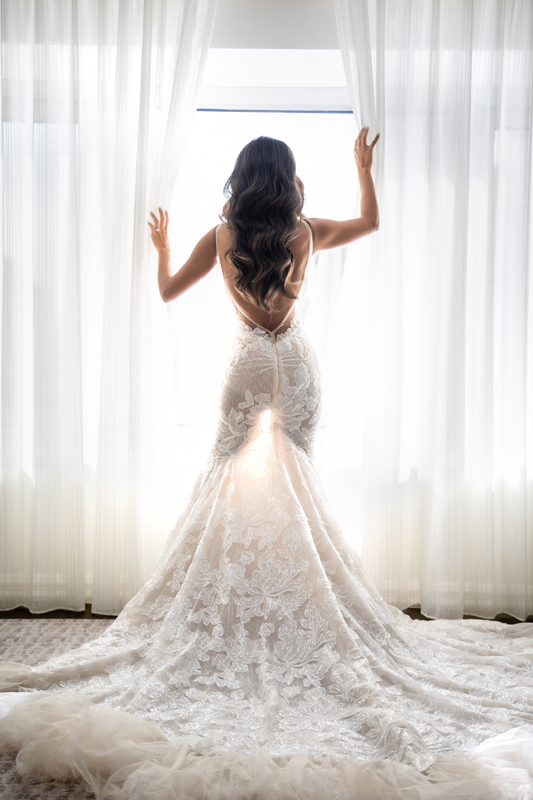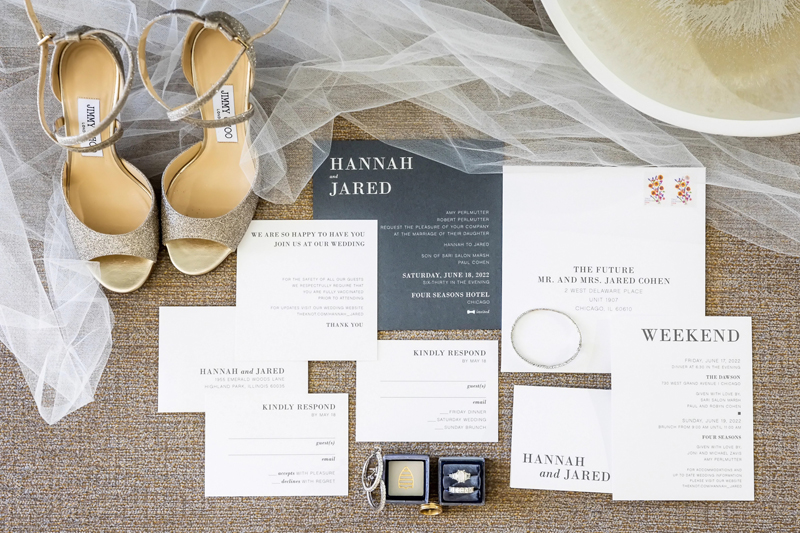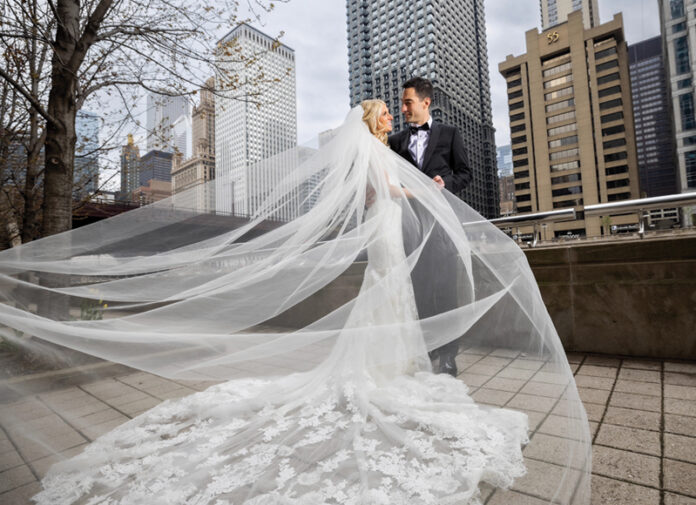By Bob Davis
Wedding photography is undoubtedly an art form that demands meticulous attention to many factors, be it the cozy confines of an indoor venue or the expansive beauty of an outdoor setting. The ultimate objective of a wedding photographer is to immortalize the most cherished moments of the couple’s special day, and each location on this journey introduces its distinct variables that require adept handling. Indoors, the photographer must grapple with the intricacies of artificial lighting, such as the soft glow of chandeliers, the warm embrace of candlelight, or the stark illumination of flash photography. Balancing these elements to craft enchanting compositions that do justice to the bride and groom’s emotions is no small feat. The photographer must become a master of ambient light, seamlessly integrating it with artificial sources to ensure that the bridal glow remains intact while capturing the intricate details of the ceremony and reception.
The challenges shift outdoors as the photographer becomes a dance partner with the sun and sky. The ever-changing natural light presents a dynamic canvas that necessitates quick exposure, aperture, and shutter speed adjustments. From the golden hues of a sunset kiss to the dappled shade under a sprawling oak tree, outdoor settings offer a cornucopia of photographic opportunities, each requiring a keen eye and swift technical skill to seize. Weather conditions, such as sudden rain or unexpected gusts of wind, can further intensify the photographer’s challenges, adding an element of unpredictability to the mix. In the realm of wedding photography, mastering the art of managing lighting indoors and out is akin to wielding a magical wand that transforms ordinary moments into extraordinary memories that will be cherished for a lifetime.
When it comes to outdoor photography, one of the critical factors that photographers must contend with is the ever-changing nature of lighting conditions. The spectrum ranges from the soft, warm embrace of the golden hour, which bathes subjects in a flattering and ethereal light, to the unforgiving harshness of the midday sun, with its stark shadows and intense highlights. Photographers employ a repertoire of techniques to harness these varying outdoor lighting scenarios. They may seek out open shade, which provides a more even and diffused illumination, or use tools like translucent umbrellas to soften the light and eliminate harsh shadows. Another ingenious approach is balancing exposure, ensuring that subjects’ faces are correctly lit while allowing the background to fade into a bright, airy backdrop. These techniques, honed through experience and technical skill, enable photographers to adapt to the unpredictable whims of outdoor lighting and produce captivating images that truly capture the moment’s essence.
In outdoor photography, the ability to navigate the nuances of light is paramount. The choice of when to shoot, whether during the serene moments of dawn and dusk or under the challenging midday sun, can dramatically affect the mood and quality of the photographs. Armed with their knowledge of lighting principles, photographers are adept at selecting the ideal locations and times to optimize natural light for their shots. Whether creating soft and flattering portraits or capturing the vibrant energy of a daytime event, these skills elevate outdoor photography from a mere visual record to an art form that resonates with viewers and preserves memories in its most radiant form.

Indoor photography presents unique challenges, primarily stemming from the often limited availability of natural light sources. In such settings, photographers frequently rely on artificial lighting solutions like Speedlites and off-camera flashes to supplement and enhance the existing illumination. These tools allow photographers to control the quality and direction of light, ensuring that subjects are well-lit and the scene is appropriately illuminated. When large group portraits are required, using substantial soft umbrellas paired with strobes becomes crucial. These large modifiers help diffuse light across a broad area, eliminating harsh shadows and creating a flattering and even illumination that is especially essential for capturing the details and expressions of multiple individuals in one frame.
The careful orchestration of artificial lighting in indoor photography is a skill that requires both technical proficiency and a keen artistic eye. Photographers must consider factors such as the color temperature of the light sources, the placement of lights to achieve the desired mood, and the avoidance of unflattering reflections or glare. By harnessing artificial lighting techniques effectively, photographers can transform dimly-lit indoor spaces into captivating and well-exposed compositions, preserving the moment’s essence with clarity and precision.
Background considerations are paramount in photography, regardless of the setting. Selecting the appropriate backdrop can significantly enhance a photograph’s overall impact, whether within the opulent confines of a grand ballroom or amidst the natural splendor of a lush garden. The background is a canvas against which the subject shines, imparting context, mood, and visual interest to the image. A carefully-chosen experience can either complement or contrast with the subject, adding depth and storytelling elements to the composition. In the art of photography, the background is not merely a passive element but a dynamic component that photographers meticulously evaluate to ensure it harmonizes with their vision, thus allowing them to capture moments that are not only visually-stunning but also emotionally-resonant.
In an outdoors setting, a clean or exciting background outdoors can complement the bride and groom without distraction. When photographing inside, photographers need to consider the décor, architecture, and available space, ensuring that backgrounds enhance rather than detract from the subjects.
Photographing groups, whether in indoor or outdoor settings, indeed presents its own set of challenges. Communication and creativity emerge as critical factors in successfully capturing these gatherings. It’s not just about arranging people in a static team photo style; photographers must aim for engaging compositions that tell a story. This involves employing techniques like layering individuals, creating depth, and emphasizing relationships within the group. The background choice also plays a crucial role in group photography, as it can either harmonize with the group’s theme or provide an exciting contrast.
Furthermore, lighting becomes critical in indoor and outdoor group photography, especially in large formal portraits. Photographers must navigate limited natural light by employing artificial lighting sources like strobes or Speedlites to ensure even illumination. Outdoors, the shifting natural light can be harnessed creatively, but it requires a keen understanding of the available light and the ability to adjust camera settings accordingly. Overall, group photography calls for a delicate balance between technical expertise and creative vision, with photographers orchestrating communication and lighting to craft compelling and memorable group shots that stand the test of time.
Selecting the appropriate lens is a pivotal decision in portrait photography, holding equal significance for indoor and outdoor scenarios. The versatility of a lens, such as the Canon EOS RF24-105mm f4 L IS USM, proves invaluable, as it accommodates a range of settings and compositions. In the context of group portraits, particularly those encompassing a substantial number of individuals, techniques like stitching and panning come into play. These methods enable photographers to seamlessly capture large groups against the backdrop of expansive outdoor vistas or within the regal confines of grand indoor halls without sacrificing image quality or depth-of-field. Therefore, lens selection becomes a cornerstone of successful group portrait photography, enabling photographers to adapt to the specific demands of each setting while consistently delivering captivating and well-composed images.
Planning and preparation are the bedrock of a seamless wedding photography operation, whether within the controlled confines of indoor venues or the unpredictable beauty of outdoor landscapes. Meticulous planning entails essential steps such as conducting site visits to familiarize oneself with the chosen locations and understanding the unique lighting conditions and potential compositions they offer. Moreover, collaboration with other wedding planners, including event coordinators and couples, is vital to ensure a synchronized approach to capturing every moment. Detailed questionnaires can help photographers gain insights into the couple’s preferences and expectations, allowing for more personalized and meaningful documentation of their special day.
Preparation extends beyond conceptualization to the tangible aspects of the job. Wedding photographers must have an intimate knowledge of their equipment, ensuring they can swiftly navigate various settings and lighting conditions. Back-up cameras, lenses, and accessories are essential to handle unforeseen technical issues during the event. Ensuring all batteries are fully-charged and memory cards are formatted and ready for use is a non-negotiable part of the preparation process. By meticulously attending to these logistical details, photographers can confidently approach weddings, knowing they are fully-equipped to capture every cherished moment with precision and artistry.
Capturing the dynamic essence of movement and engaging with children are integral aspects of successful wedding photography, irrespective of the setting – be it indoors or outdoors. The energy on the dance floor and the spontaneous interactions with children hold a special place in the wedding narrative. To capture these instances with precision, photographers often employ specialized techniques. For example, courses like rear curtain sync and a slow shutter speed can be used when photographing dancing, creating a beautiful sense of motion and a vivid trail of lights, which adds a dynamic and artistic touch to the images. When it comes to engaging with children, it’s all about establishing a playful rapport. Photographers often crouch down to the children’s eye level, interact with them in a friendly and non-intrusive manner, and use candid shots to encapsulate the authenticity of their interactions. These methods equally apply in indoor and outdoor settings, allowing photographers to freeze those fleeting moments of joy and movement for eternity.

Effective communication and collaboration with wedding venues and guests are pivotal to the photographer’s success. Before the wedding day, working closely with venues through physical walkthroughs or virtual scoping is essential to gain a comprehensive understanding of the available spaces and lighting conditions. This enables photographers to plan their shots and anticipate potential challenges. Furthermore, encouraging guests to participate in candid moments while respecting the photographer’s role is crucial for creating a harmonious atmosphere. Whether it’s a serene garden, a picturesque beach, the solemnity of a church, or the opulence of a banquet hall, the collaborative effort ensures that everyone can relish the day while the photographer captures the wedding’s essence authentically and unobtrusively. This synergy between professionals, venues, and guests results in a seamless and memorable photography experience, no matter where the celebration occurs.
In wedding photography, navigating the intricacies of indoor and outdoor settings is paramount. The photographer’s skillset must encompass a multifaceted approach that encompasses understanding and mastering lighting conditions, making judicious choices about backgrounds, adeptly engaging with diverse groups and children, and meticulous planning, all while collaborating effectively with venues and guests.
Wedding photographers must be adaptable problem solvers, equipped to handle the myriad challenges and seize each location’s creative opportunities. By wholeheartedly embracing both the complexities and the potential of location-based photography, they have the power to craft enduring visual narratives that mirror the unique love story of the couple, convey the profound joy of their families, and encapsulate the distinctive ambiance of their chosen venue, whether it be an intimate indoor setting or the grandeur of an outdoor backdrop. Ultimately, this ability to blend technical expertise with artistic vision allows wedding photographers to transform fleeting moments into timeless memories, inside or out.
 Bob Davis and his wife, Dawn, are based in the Chicagoland area who have photographed celebrities around the world and have been featured in publications such as People, InStyle, Modern Luxury Brides, and many others. Bob is a member of Canon Explorers of Light, Westcott Top Pro Elite, ProMedia Gear Influencer. They have authored two books, “Lights Camera Capture” and “We’re Engaged!” In December, they will host “Wings of Wonder: An Unforgettable Birds in Flight Photography Workshop at Bosque del Apache” in New Mexico. For more information, contact them at: bob@bobanddawndavis.com.
Bob Davis and his wife, Dawn, are based in the Chicagoland area who have photographed celebrities around the world and have been featured in publications such as People, InStyle, Modern Luxury Brides, and many others. Bob is a member of Canon Explorers of Light, Westcott Top Pro Elite, ProMedia Gear Influencer. They have authored two books, “Lights Camera Capture” and “We’re Engaged!” In December, they will host “Wings of Wonder: An Unforgettable Birds in Flight Photography Workshop at Bosque del Apache” in New Mexico. For more information, contact them at: bob@bobanddawndavis.com.











